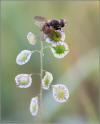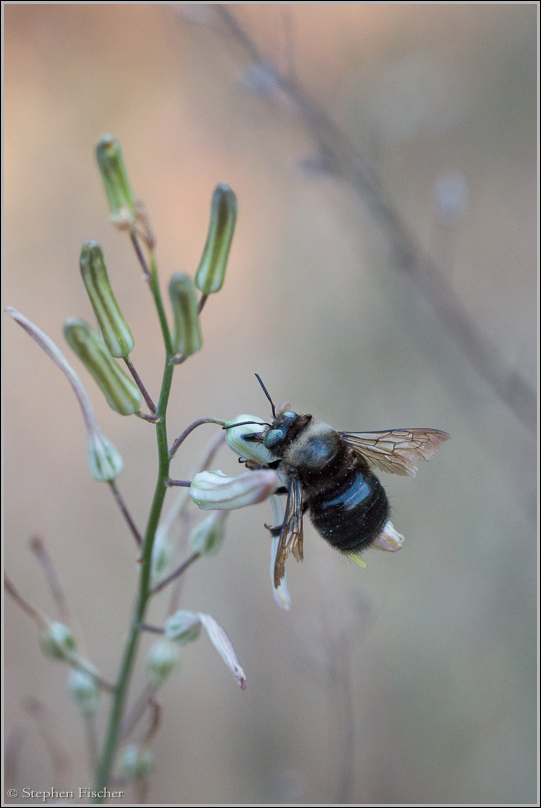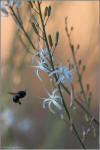Picture of the week
| Previous weeks |
 June
1, 2014 June
1, 2014 |
 May
25, 2014 May
25, 2014 |
 May
11, 2014 May
11, 2014 |
 Apr
27, 2014 Apr
27, 2014 |
 Apr
20, 2014 Apr
20, 2014 |
|
|
 Apr
6, 2014 Apr
6, 2014 |
|
|
|
|
 Mar
9, 2014 Mar
9, 2014 |
 Mar
2, 2014 Mar
2, 2014 |
 Feb
23, 2014 Feb
23, 2014 |
|
|
| Older |

Carpenter bee robbing a soap plant
Carpenter bee robbing nectar from a soap plant flower that has yet to open. Most bees must wait until the flower is actually open before getting to the nectar inside. But the carpenter bee, being the largest bee in North America, has a fairly large probiscus, and is able to puncture the base of the flower to reach it earlier than the flower intended. Carpenter bees may at first look intimidating, but are fairly docile towards humans, too busy focusing on collecting nectar. Also note the worn wings on this particular bee, indicating it is getting nearer to the end of its useable life. It is quite amazing that these wings can even support the flight for such a large bee.
 The
soap root plant is unique in that it only blooms in the evening, a few
flowers for each stem at a time. By the next morning the flowers in
bloom wilt away, leaving a stalk with no flowers visible during the day
until that evening when a new set come into bloom. Various species of
bees seem to have a strong attraction to this particular plant, and have
figured out the timing, showing up each evening during the month it is
active. Another image of this beautiful plant in bloom is shown here with an
approaching carpenter bee. I found some large groups of these plants
recently on the American River parkway during an evening walk. I may
not have payed enough attention before, but this year seems particularly vibrant
for this particular plant.
The
soap root plant is unique in that it only blooms in the evening, a few
flowers for each stem at a time. By the next morning the flowers in
bloom wilt away, leaving a stalk with no flowers visible during the day
until that evening when a new set come into bloom. Various species of
bees seem to have a strong attraction to this particular plant, and have
figured out the timing, showing up each evening during the month it is
active. Another image of this beautiful plant in bloom is shown here with an
approaching carpenter bee. I found some large groups of these plants
recently on the American River parkway during an evening walk. I may
not have payed enough attention before, but this year seems particularly vibrant
for this particular plant.
This image was captured with a Canon 70D + 100mm L-series f/2.8 macro lens with settings of 1/320 sec, f/8, and ISO 1600. I have been pleased with the performance of this lens, plus the improved higher ISO capabilities of the 70D has been quite effective in maintaing sufficient shutter speed and depth-of-field necessary to control the desired focus range.
All content and images are property of Stephen Fischer Photography, copyright 2014. Last updated: 6/8/2014 ()